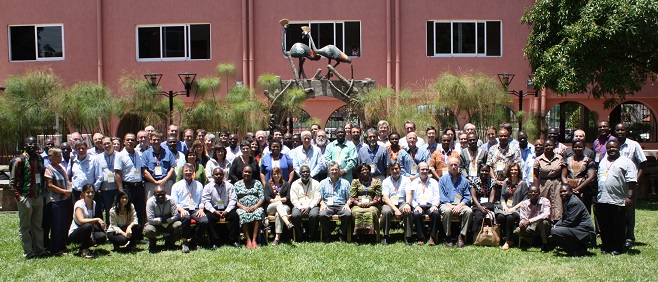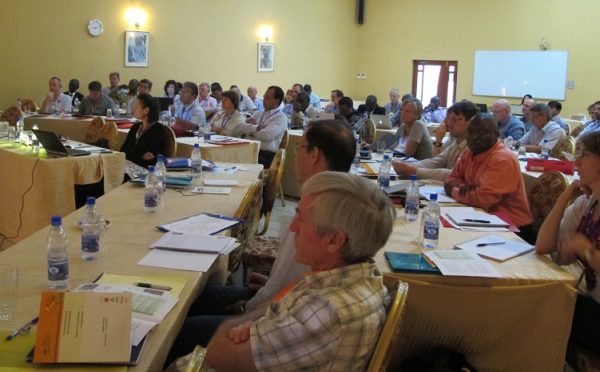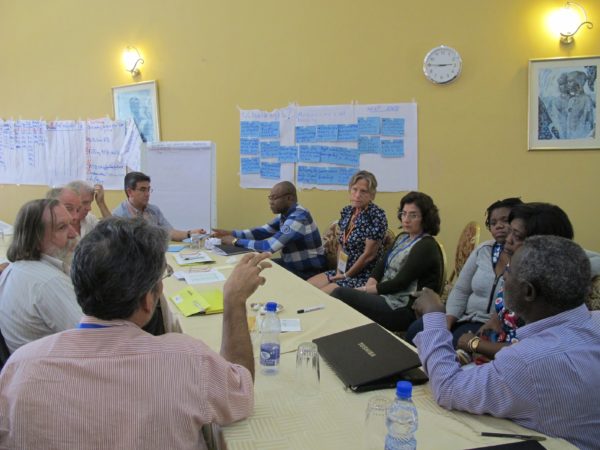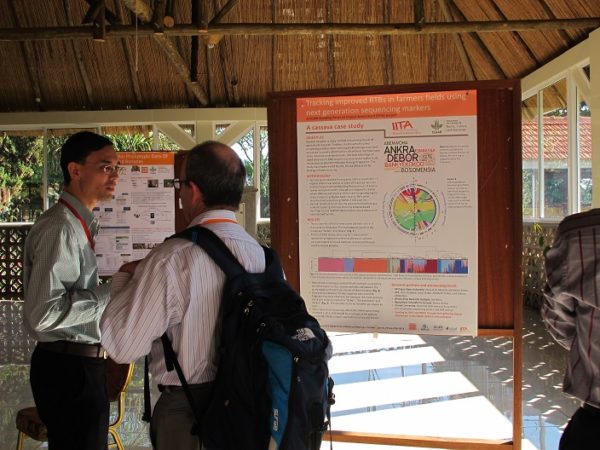CGIAR research programs all share the challenge of having team members from different backgrounds and centers working in many countries. We have to show that we are up to the task that we are given – that of collectively making a difference in the lives of the poorest people in the world, millions of whom depend on roots, tubers and bananas for food and income. In this spirit, more than 60 people met in Entebbe, Uganda from 29 September-3 October to review current research in RTB and develop our new flagship projects which will guide us through to the second phase. We picked Uganda as a country where all our crops are important, all the centers have projects, and where we have a great group of collaborators.
We were fortunate to be joined by Joe Huesing from USAID, who commented that “clearly a lot of thought looking at mission, vision and cost, scope, etc. had occurred before the meeting.” For him, science in RTB is the “easy part”: “People in RTB have a great scientific track record”, he said, “and there are great products in the pipeline”. The hardest part, he noted, will be to exercise operational control to bring this together in an effective and timely product development cycle. RTB is “well positioned to do this”, he added, and “the biggest impact will be from the excellent organization thus far achieved”.
Getting back to the science!
We began with two Science Days: each theme leader summarized science progress, followed by presentations on specific topics in the theme and a lively discussion to identify advances and challenges. Highlights ranged from updates on our work with metabolomics which shows progress with the use of these new technologies to increase the accuracy and significantly accelerate the pace in which we discover and transfer traits into superior new breeding materials to a study in Malawi of gender norms and marketing of seed and ware potato.
At the end of the science days, rapporteurs described in three minutes grand challenges and progress for each theme. Many participants commented that after so much planning it was great to see our investment bearing fruit. “We discussed synergies in RTB so many times in planning that it’s wonderful to see the results coming through to show that the original concept really makes sense”, commented Graham Thiele, the RTB Director. It was a great opportunity to count on the presence of scientists from NARO, institutions that are working with RTB on different crops, as Yona Baguma, Deputy Director of Research, explained in his much-appreciated presentation.
Getting the flagship projects afloat
After the science days we moved on to sharing and developing the Management Committee ideas for the new flagship projects, which neatly organized the delivery flagship projects by crops. Ann-Marie Izac of the Consortium Office, however, pointed out that such structure might not leverage synergies across centers and would convey a message that the research program is not integrating its work across crops. Working groups started reviewing different scenarios for flagships and robustly rejected the Management Committee’s preferred option. Instead they suggested a set of delivery flagship projects organized by outcomes: productive crops, resilient cropping systems, nutritious foods and value adding for income. We picked up this recommendation and moved on to reorganize the program for the remaining days around developing the content of this set of flagship projects. Merideth Bonierbale (CIP) commented that the flexibility to make this mid-course change was “one of the most positive features of the meeting”.
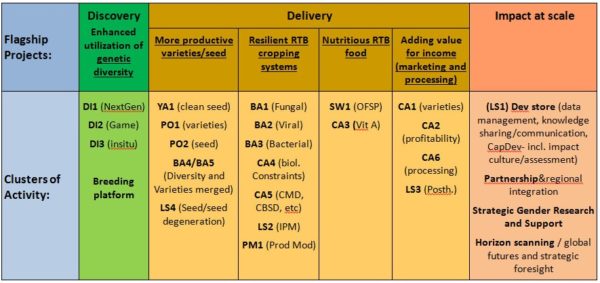
Getting to know local partners
The meeting was also a timely opportunity to present the EC-funded Project on expanding utilization and reducing postharvest losses of RTB crops in Uganda that was launched earlier this year. The objective of the project, which is part of an ongoing collaboration between RTB and UK’s Natural Resources Institute (NRI), is to improve food availability and income generation through better postharvest management and expanded use of RTB, based on postharvest and processing technologies, value chain development and capacity development. A rotating knowledge fair was organized where local partners presented the different business cases in five minutes using a poster format to small groups of participants.
Another highlight was the presentation by Joseph Methu of Asareca who explained that partnerships are instrumental in the delivery of ASARECA’s mission and that working with CGIAR, including CGIAR research programs, is key for impact in East and Central Africa.
Poster competition stirs up interest
Given the diverse research topics and places you can find among RTB members, keeping everyone up-to-date about the ongoing work is a challenge, and an annual meeting is supposed to help with that. Taking stock of the work currently being done seems to be a great attraction for many of the scientists who made the journey to Entebbe from Peru, Vietnam or Belgium.
Another way to share knowledge and information about ongoing research is through scientific posters. What works better with scientists than a poster competition? Close to 30 posters were brought to Entebbe and displayed on the first day, ranging from crop ontology to the use of sequencing markers to fighting cassava pests and diseases. Even after a long first day of presentations, and jetlag still taking a toll, two hours were well spent going from one poster to another and filling out an evaluation form. The popular vote eventually went to the poster titled “Tracking improved RTBs in farmers’ fields using next generation sequencing-markers: A cassava study”, while an external jury composed of special invitees – local partners and international donors – selected the poster presenting the work on “Genetically modified bananas resistant to Xanthomonas Wilt”.
Most presentations are available on SlideShare
More photos on Flickr
By Véronique Durroux-Malpartida
